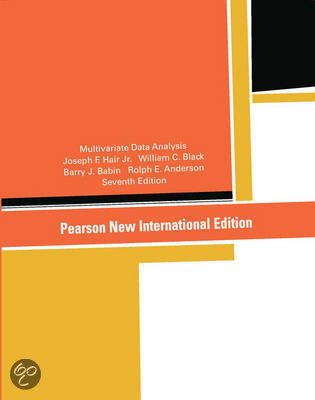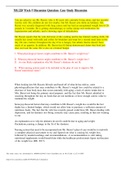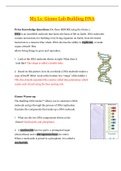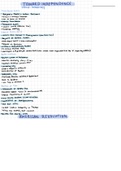Introduction
Independence and dependence techniques
Factor analysis Multiple MANOVA SEM
regression
Technique Independence Dependence Dependence Dependence
Variables Not defined if One dependent More than one More than
dependent or variable dependent one
independent variables dependent
variable
Type of - Metric Independent Independent
measuremen variable is variable is
t scale nonmetric metric
Types of multivariate analysis
Principal Multiple Logistic Multivariate Structural equation modeling
components regression regression analysis of (SEM) and confirmatory factor
and common variance and analysis (CFA)
factor analysis covariance
(PCA)
Finding Single metric Single non- Two or more Structural model: relations
underlying dependent metric dependent metric dependent between dependent and
dimensions variable variable variables independent variables
(factors)
Minimal Two or more Two or more Two or more non- Measurement model: to use
information loss metric or non- metric or non- metric independent several variables to measure a
metric metric variables single dependent or independent
independent independent variable (concept)
variables variables
No assumption of MANCOVA can be
multivariate used to control for
normality covariates
, Factor analysis
Exploratory Factor Analysis
Exploratory factor analysis
Process Decisions Decision rules / logic SPSS output
1. Problem Objective: data summarization or Data summarization Principal Components n.a.
formulation data reduction Analysis
Data reduction Principal Axis Factoring (=CFA)
Variable definition/selection Based on theory n.a.
Metric scale (interval and ratio)
Sample size: rule of thumb is 4-5 items *
number of respondents
2. Construct the How do the variables correlate to -
correlation matrix each other?
To get a general idea
KMO >0,50
Can we use Factor Analysis with
this correlation matrix? Bartlett’s significant at p<0,05
- KMO
- Bartlett
3. Select the First, determine whether
extraction Principal Components
method Analysis or Common Factor
Analysis
(PCA vs. CFA)
Differences are clarified below
this table
,4. Determining 1. Eigenvalue At least 1
number of factors 2. A priori criterion Number of factors based on theory
3. Total variance explained Cumulative percentage of 60
4. Scree plot (knot-criteria) Use the number of factors at the knot (see image)
5. Rotating 1: Orthogonal factor rotation Decision should be based V1 and V3 load high on F1
factors (varimax) = axis are maintained on theoretical and low on F2.
at right angles of 90 degrees considerations.
Rotated Factor Matrix Preferably start with
orthogonal factor
rotation.
Factor correlation matrix: F1 and F2 do not
2: Oblique factor rotation (Direct correlate significantly
Oblimin) = axis are not on each other
maintained at right angles of 90
degrees
Factor Correlation Matrix /
pattern matrix
6. Interpreting 1: Orthogonal Factor Rotation Variables should form clusters of high loading on one
factors factor. By this way you can identify odd variables and
if the factor analysis identified the right factors with
corresponding variables
, 2: Oblique Factor Rotation
7. Using factors 1: Factor scores Composite measure of each factor for each respondent
in other analyses based on the factor loadings of all variables.
Advantage: SPSS does it for you
Disadvantage: not easy to replicate across studies
2: Surrogate Variables Select the highest loading variable as the surrogate for
the factor
3: Summated scores Select highest loading variables and use average score
of the respondent on these variables
8. Determining Step 1: reproduce correlations IF the differences (read: residual) are small, there is a
model fit between variables and factors good fit
from the estimated correlation
matrix
Step 2: compare differences
between the observed
correlations (input correlation
matrix) and reproduced
correlations (as estimated in
factor matrix. Differences are
called Residuals
To complete analysis, perform Reliability Analysis (in table below)











